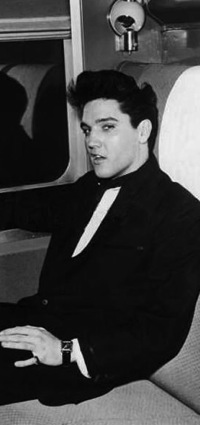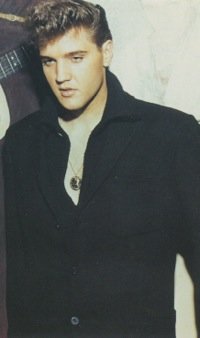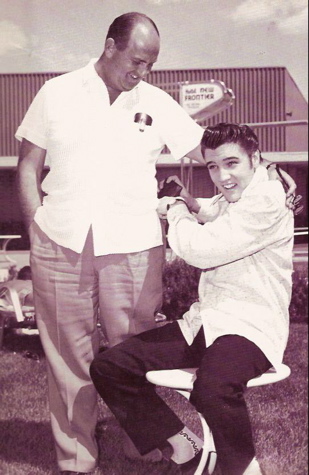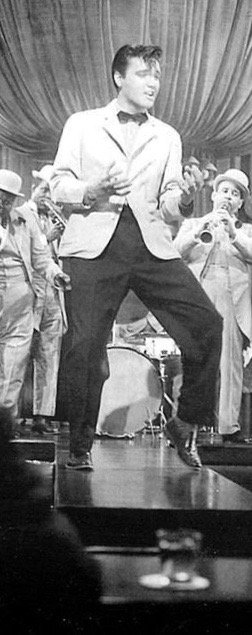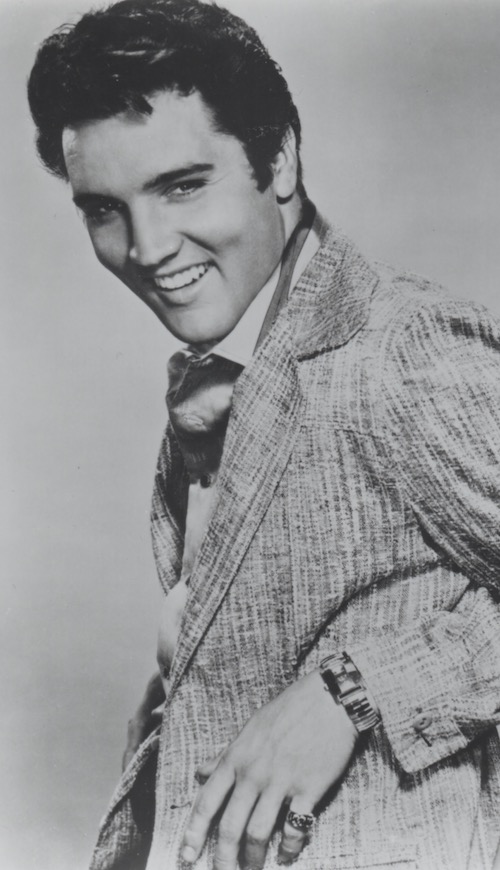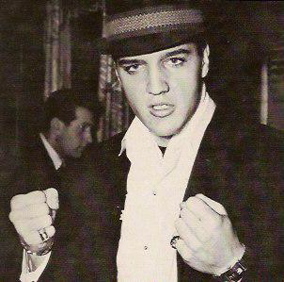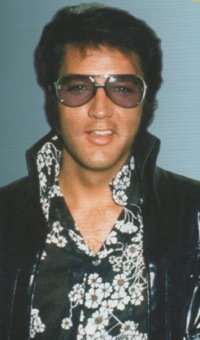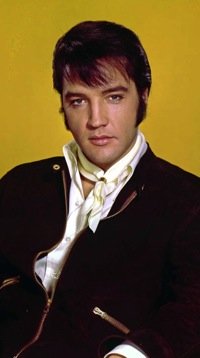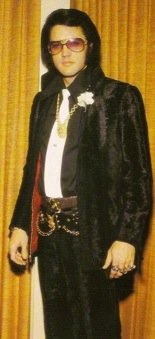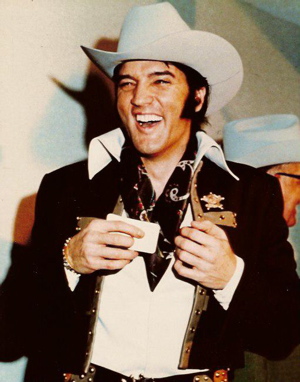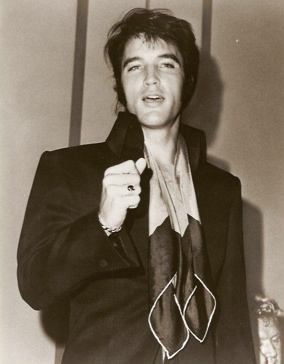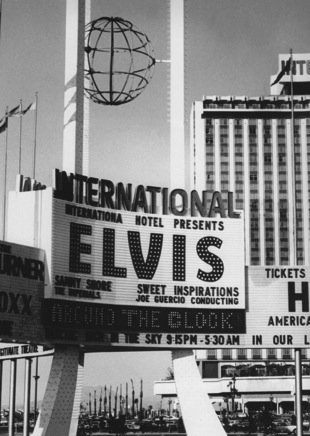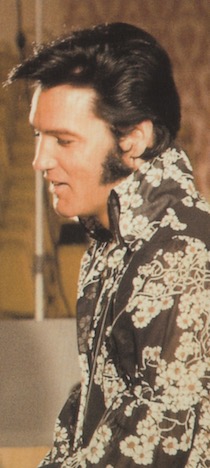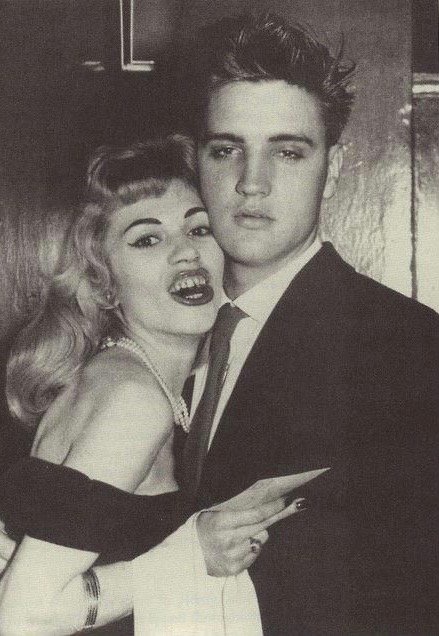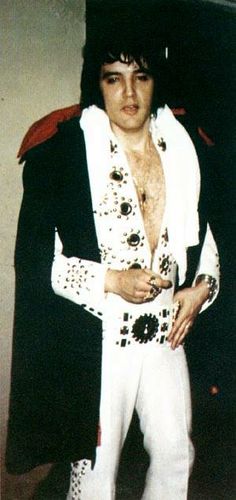Elvis History Blog
Sammy Davis, Jr.
Elvis' Closest Celebrity Friend
“Certainly of the entertainers who claimed to be one of Elvis’ close buddies, only Sammy Davis, Jr., was really a friend. He never wanted anything except to have a good time.”
— Marty Lacker, Revelations from the Memphis Mafia, 1995
Readers of Peter Guralnick’s definitive two-volume biography of Elvis Presley might conclude that Sammy Davis, Jr., was just one of hundreds of people whose lives infrequently and inconsequentially passed through the edges of Elvis’ starlit life. Guralnick briefly mentions Davis’ name in passing only a handful of times. However, the journals of Elvis insiders and Davis’ autobiographical writings reveal that he was a frequent and significant presence in Presley’s life for more than 20 years.
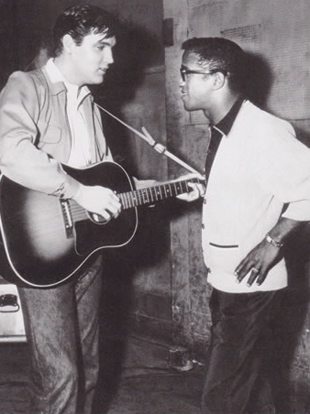
Sammy Davis, Jr., was born on December 8, 1925, exactly nine years and one month before Elvis Presley. By the time they first met in early 1957 on the set of Presley’s film Loving You, Davis already had achieved fame as a club entertainer, a recording artist, and a Broadway performer. In two later autobiographies, Yes I Can (1965) and Hollywood in a Suitcase (1980), he explained what drew him and Elvis into an instant friendship. “Both of us were rebels in our own ways, and we’d gravitated toward each other,” he noted. “We both had motorcycles, I had a cut-down Harley and we ran together whenever we were in the same town.” (Right: On the set of King Creole)
From the beginning, Presley and Davis shared a mutual fondness for having a good time. When both were in Los Angles in 1957, Sammy often made the party scene in Elvis’ Beverly Wilshire penthouse suite. In his book, Elvis: My Best Man, George Klein recalled how Sammy outshined all the other celebrities present at Presley’s party following his concert at the Pan Pacific Auditorium on October 29, 1957.
“The party at the Beverly Wilshire after that second show was a great one, with all kinds of celebrities mingling about … [Sammy] and Elvis got along right away, and, as much as Elvis was the star of that party, Sammy wasn’t in our suite ten minutes before he was performing a private show for all of us. I don’t remember the whole act, but I do recall that he and Nick Adams had everyone busted up with dueling Brando imitations.”
• Sammy's Jekyll and Hide scared Elvis
Davis remembered using a couple of unusual visual aids during a spontaneous routine at another Beverly Wilshire penthouse party.
“Up in his living room he was at the piano. Nicky Blair, Nick Adams, Natalie Wood, Dennis Hopper, and some kids not in the business were there. Elvis started doing Ray Charles. He was a marvelous impressionist. I could do Ray but not with the piano. Elvis did the best white Ray Charles I’ve ever heard. I said, ‘Okay, pal of mine, I’ve got one for you. Dr. Jekyll and Mr. Hyde.’ Elvis went over to a couch and the kids who’d been standing around him at the piano all took their places to watch me.
“I was wearing my hair very long and I roughed it up and strung it out like the mad Mr. Hyde. I took out my bridge, and my (false) eye, and I did the crazy eyes and bent over. I did the heavy breathing that Fredric March did. I leaped onto the couch next to Elvis, screaming, ‘I’m free … I’m free …’ He cringed. ‘Don’t touch me.’ He was really upset, so I came out of the character. He was still half nervous. 'Put your teeth back and your eye and comb your hair.’ Then, when I looked like me again, he relaxed. ‘You’ve gotta put that in the act,’ he said.”
Several nights later, as Sammy prepared for his second show at the Moulin Rouge in Los Angeles, he was told Elvis was sitting at ringside. He told his road manager to stand in the wings and be ready to catch him at the end of the show.
“I did the whole show, did the impression of Elvis with the white shoes and the guitar. Then I said, ‘This is for my man.’ I did about two minutes of Jekyll and Hyde dialogue, ending in screaming, ‘I’m free, freeeee …’ and I ran and leaped high into the wings.”
• Sammy and Elvis … The Defiant Ones
In addition to being party pals in 1957, Sammy and Elvis planned a professional collaboration that year. In his autobiography, Sammy claims he and Elvis were being considered for the lead roles in producer Stanley Kramer’s upcoming film, The Defiant Ones. The script dealt with two chain-gang prisoners, one white, one black, who escape while chained together. Forced to work together, the two men develop a deep respect for each other by the end of the movie.
“It was a real heavyweight drama,” Sammy recalled. “Our chemistry on the screen and in the press could be sensational.” Of course, when Colonel Parker heard about the idea, he killed it. Davis said Elvis had tears in his eyes when he explained his manager’s reason for doing so. “He says that all those people out there who buy my albums, among them are lots who won’t want to see me chained to a colored guy and end up liking him.” Sammy called the project’s failure one of the “great disappointments” of his life.
Elvis’ performance in 1958’s King Creole affirmed Sammy’s belief that Elvis could have handled the dramatic role in The Defiant Ones. (Instead, the role went to Tony Curtis opposite Sidney Poitier.) “He had a great talent as a screen personality,” Davis asserted, “and a couple of things he did, like King Creole, showed genuine promise.”
His entrance into the army in March 1958 took Elvis away from Sammy and the Hollywood scene for two years. Early in that year, though, Davis visited Elvis on the Hollywood set of King Creole, and in August Sammy was one of many celebrities who sent Elvis a telegram of condolences following the death of his mother.
• Elvis' one night with the "Rat Pack"
In 1959, while Elvis was serving in Germany, Davis worked often on screen and stage with friends Frank Sinatra, Dean Martin, Joey Bishop, and Peter Lawford. Elvis met the “Rat Pack” in March 1960, when he made his first post-army appearance in Miami on Sinatra’s TV special. In his 1994 book, Good Rockin’ Tonight, Presley friend Joe Esposito, recreated the scene.
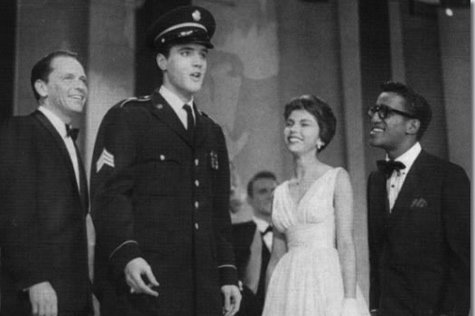
“Elvis and I quickly settled ourselves in and headed downstairs to the hotel’s Grand Ballroom for a meeting with Frank Sinatra and his group … Joey Bishop, Sammy Davis, Dean Martin, Peter Lawford were all there, all sporting their signature casual, style—beautifully tailored slacks topped by button-down-collared shirts and luxurious cardigan sweaters. Dean Martin was approachable, very friendly and laid-back, as was Sammy Davis, Jr. Sammy had absolutely no pretensions, and he and Elvis became great pals.”
When Elvis returned to Hollywood in 1960, the party scene began anew. Although he was 35 that year, Sammy Davis, Jr., joined in the juvenile antics in Presley’s hotel suite. “Elvis got wild as a goat in ’60,” Lamar Fike explained in Revelations from the Memphis Mafia. “We’d stayed at the Beverly Wilshire, and things had gotten kind of touchy a time or two. Like the time Sammy Davis, Jr., came over and we were throwing whole pizzas at each other.”
• Sammy saw Elvis' frustration in Hollywood
As a close friend throughout the sixties, Sammy witnessed Elvis’ growing frustration with his Hollywood career. “They put him in that million-dollar-a-picture mold for the teenyboppers, and Colonel Tom wouldn’t let him change,” Sammy observed. “I know that Presley got fed up with it. After twenty or so pictures he refused to make another one. ‘I’ve done it all already. I can’t go on making the same film over and over again,’ he told me.”
Davis compared Elvis’ situation with that of another performer who early on got boxed-in by Hollywood.
“Elvis had exactly the same problem as Jerry Lewis. He’d created an artistic niche, and people were buying it. Everyone implored him not to change it while the money was rolling in. With both of them, the artistic urges began to take over, and they were desperate for change. They wanted the public to know they could do something else. Remaining the teenage idol when Presley was forty didn’t work. Yet when he tried to change it, he upset his loyal fans. Presley had to continue being the plump, middle-aged, wrinkled teenager.”
• Sammy was Elvis' biggest fan in Vegas
Sammy was in the audience on opening night when Elvis made his stage comeback at the International Hotel in Las Vegas on July 31, 1969. After the show, Davis went backstage to congratulate Elvis. “Sammy gave Elvis a big hug and told him how great he was,” recalled Joe Esposito. His enthusiasm, along with that of many other celebrities, made Elvis “incredibly happy,” noted Joe. In a later interview, Sammy declared, “Man, I’ve been performing in Vegas almost since Vegas opened. And I have never, ever seen somebody fill a two-thousand-seat room.”
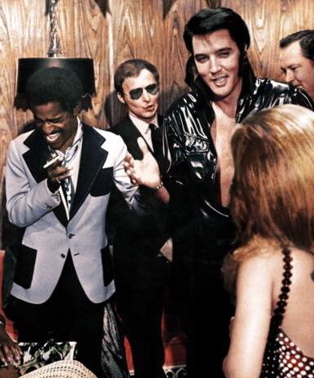
Davis would attend most every Presley opening in Las Vegas in the seventies. According to Esposito, Elvis got a great audience reaction from Sammy, who was “always jumping up and down in his chair, applauding wildly and shouting encouragement.” During one Vegas show in 1970, Elvis took off his 52-carat black star sapphire ring and gave it to Sammy. “He said it was only right,” Marty Lacker recalled Elvis saying. “Sammy was the biggest black star in the world.”
Even in Elvis’ Las Vegas glory days, though, Sammy could sense a yearning for something more. “Presley was philosophical about his artistic frustration,” Davis observed. ‘How can I moan when I’m still making ten million dollars a year?’ he said in Vegas. ‘I’m still packing places. I’ve got no right to bitch.’ He couldn’t fight it and go out and do two shows a night.”
• Elvis and Sammy … the Nixon connection
In the early ’70s, both Elvis and Sammy had celebrated encounters with President Richard Nixon. Presley’s came during a secretive late-night visit to the White House in December 1970. He had come to ask the President to give him a badge for the Federal Bureau of Narcotics and Dangerous Drugs. When Nixon agreed, Elvis hugged him, surprising the President and everyone else in the room.
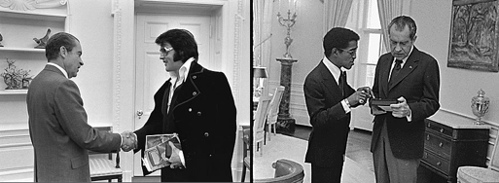
Sammy Davis, Jr., also hugged President Nixon, but, unlike Elvis’ embrace, Sammy's occurred at a public event and caused controversy. After Davis performed at a Nixon rally at the 1972 Republican National Convention in Miami, the President came on stage to thank Sammy. “So touched, so overwhelmed by the realization that my problems were on the President’s mind,” Davis explained, “I walked up from behind him and put my arms around him, hugged him, and stepped back.” Sammy's spontaneous act drew public criticism from prominent political figures, both black and white.
Throughout the seventies, Elvis’ and Sammy’s paths crossed in Las Vegas, where both worked often. Once every two or three years, the two stars would spend a day together. Davis told about one evening in Vegas when he and Elvis rode around town in Presley’s limousine hitting all the “joints.” Other nights, according to Sammy, the two would sit around and watch old movies from midnight until dawn. “He’d pour his heart about how he wanted to do a film without a single song.”
• Sammy on the passing of Elvis Presley
In the mid-seventies, though, Sammy began to notice the physical changes in Presley. “Elvis was troubled and puffy in the face and the contrast was so great from when I had first seen him at the Hilton, when I heard the theme from 2001: A Space Odyssey and he’d walked out and you heard dong, dong, dong, dong … and he was in shape and he wore the skintight clothes and women were going crazy and men were going, ‘Yeah … he’s something!’ He’d looked like ice cream and cake then. And me? I couldn’t stand to think about it.”
On August 18, 1977, Sammy Davis, Jr., attended Elvis Presley’s funeral in Memphis. In a memoir published in 1980, Davis included the following eulogy for his long time friend:
“I don’t trust the spate of books that came out after Presley’s death. They showed him as a morose man, bedeviled with fears and doubts. That was certainly not the Presley I knew. He had a great sense of humor, and he was always full of fun. I guess all stars have their down periods, even deep depressions, and I don’t think he was any different. But when I was around Elvis, they all were good times. We had a ball. There were no brooding depressions. He was the original average guy made good. He really was a plain, openhearted country boy. His only frustration was that he needed to stretch himself more. After his entourage and the public between them had forced an image on him, he had to lock himself into a private frame to be himself. Unlike me, he was never allowed the flexibility he needed as an artist.”
Sammy Davis, Jr., outlived Elvis by nearly 13 years. He died of throat cancer on May 16, 1990, at the age of 64. He was interred in Forest Lawn Memorial Park in Glendale, California. — Alan Hanson | © February 2013
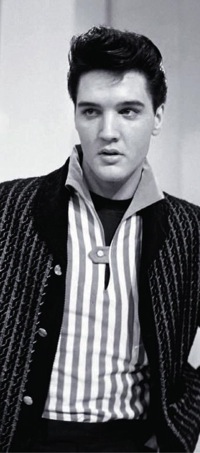
"When I was around Elvis, they all were good times. We had a ball. There were no brooding depressions. He was the original average guy made good. He really was a plain, openhearted country boy."
— Sammy Davis, Jr.
